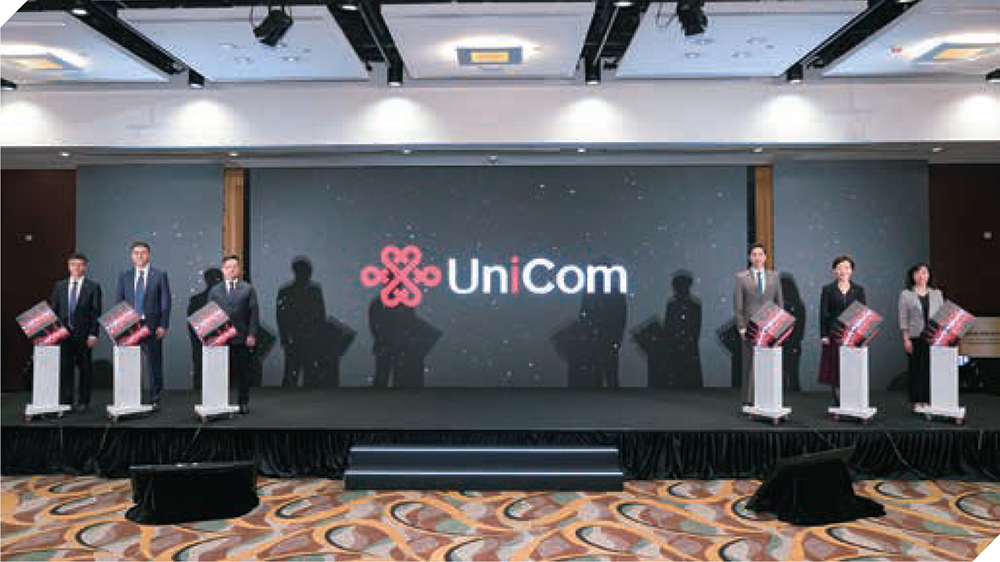In 2024, China Unicom actively served the national strategy, accelerated the progress of crucial tasks such as innovation-driven development, open integration, enterprise reform, and system establishment. The Company has accelerated breakthroughs in key bottlenecks such as technological research and foundational management. The Company adhered to the guiding principle of seeking progress while maintaining stability, with overall business and operations showing a positive trend, improved structure, enhanced quality, and strengthened momentum for high-quality development.
The supporting effect of Connectivity and Communications (CC) business has become more prominent. Firstly, the Company made every effort to stabilise operations and promote development, achieving positive progress in coordinating effective quality enhancement and reasonable quantity growth. Secondly, the Company adhered to new integration as the key tactic to promote scale development and value enhancement. Its mobile connectivity and broadband connectivity experienced steady growth, with FTTR, where the Company maintained an industry-leading market share, becoming the primary driver of revenue growth. Its mobile billing subscriber scale exceeded 340 million, with a cumulative net addition of 10.68 million. Its fixed-line broadband subscriber scale exceeded 120 million, with a cumulative net addition of 8.84 million. Both mobile and broadband subscriber scales reached historical highs. Thirdly, the Company made innovative breakthroughs in TV connectivity and information services. The subscriber base for key products such as Unicom UHD, Unicom Cloud Drive, and Unicom Housekeeper continuously increased and led to significant revenue growth. To facilitate the upgrade of digital consumption and achieve product integration with cloud, AI, security, and communication, the Company launched new products such as Unicom Cloud Phone, Unicom Cloud Computer, Unicom Security Manager, and Unicom Family V-Net. Fourthly, the scale of Internet of Things (IoT) connections increased rapidly, with more than 620 million IoT connections and the scale of 5G IoT business led the industry. The scale of Internet of Vehicles (IoV) connections exceeded 76 million, ranking first in the industry.

The development capabilities of Computing and Digital Smart Applications (CDSA) business have been continuously strengthened. Firstly, Unicom Cloud’s market share in key areas such as government clouds, medical clouds, and SOEs’ cloudification continued to expand, creating over a thousand self-developed cloud benchmark projects. Unicom Cloud’s cloud resource pool experienced rapid growth with doubled sale scale. Key products such as Video Cloud and Cloud Desktop tripled in sales year-on-year. Secondly, the Company seized the development opportunities of artificial intelligence and the national “Eastern Data and Western Computing” strategy, deeply cultivating industry markets in the data centre business and driving the increase in business share of data centre. Thirdly, the Company’s data service revenue maintained rapid growth, the big data market share among operators and leading for 6 consecutive years. China Unicom was the first in the industry to launch the Union Data Network and Trusted Data Resource Space products, actively positioning itself for data factor reform. Fourthly, the Company achieved remarkable results in the scale development of digital smart applications, implementing over 40,000 5G industry application projects, serving over 16,000 5G private network customers, and cumulatively building over 7,100 5G factories. The Company continuously enriched its supply of professional, specialised, digital and intelligent application products, with over 50 self-developed application products which generated revenue in excess of RMB100 million. It upgraded its 5G industry private network product system to version 4.0, and created over 10 5G RedCap industry terminals. The Gewu Unilink industrial internet platform became one of the first national-level Class A “dual-cross” platforms. Fifthly, in terms of cybersecurity, the Company upgraded the “component + platform + service” new security operation service model based on the “Mogong” platform with Unicom’s distinctiveness. Focusing on key areas such as urban security operations and SOEs, it successfully implemented over a hundred benchmark projects. The “Mogong” product was selected in the first list of projects for the Application Expansion Project of Central State-Owned Enterprises by the State-owned Assets Supervision and Administration Commission of the State Council, being the only product selected in the security field nationwide. Sixthly, the Company accelerated its development in the field of artificial intelligence, with its general large models ranking among the top five in 17 international mainstream benchmarks. Its Retrieval Augmented Generation (RAG) and AI agents received the highest ratings from the China Academy of Information and Communications Technology (CAICT). It has built 37 industry large models and created over a hundred application cases. Among them, the industry models in four sectors, namely government service hotlines, public security, economic operation, and cultural heritage and innovation have achieved large-scale replication.
The Company’s high-quality network capability continuously enhanced. The Company continuously promoted the construction of mobile premium networks, broadband premium networks, and government & enterprise premium networks, establishing a solid capability foundation for CDSA. The Company focused on enhancing its core competitiveness, sustainable development capacity, and value creation ability, driving network quality to a new level and further solidifying the network foundation for China Unicom’s high-quality development. Firstly, the Company implemented the “signal upgrade” strategy by comprehensively promoting low-band sharing. The Company had 1.375 million 5G mid-band shared base stations and 700,000 900MHz low-band base stations. The mobile network coverage rate in administrative villages achieved 99%. Secondly, the Company continued to enhance gigabit optical network coverage, with the number of broadband ports exceeding 280 million. It largely completed the deployment of 10G PON in developed towns and above regions, with the proportion of 10G PON ports increasing by 8.3 percentage points to 81.7%, leading the industry. Thirdly, the Company actively constructed multi-level computing power supply. Its IDCs fully covered the “Eastern Data and Western Computing” hub nodes, with significantly enhanced AI compatibility in core regions. The total number of cabinets exceeded 420,000, with AI-compatible power reserve increasing rapidly to 270 MW. Intelligent computing capacity exceeding 17 EFLOPS, and the cloud pools covered more than 270 cities. Fourthly, the Company continued to improve its international network deployment, with international submarine cable capacity exceeding 100T, international Internet outbound capacity at 5.72T, and inbound bandwidth at 6T. International roaming covered 663 operators in 264 countries and regions.










